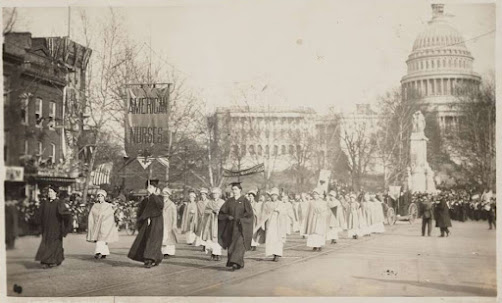On March 3, 1913, a historic and tumultuous event unfolded in Washington D.C. as a women's suffrage march, marking a turning point in the fight for gender equality in the United States.
This event, which took place just one day before President Woodrow Wilson’s inauguration, underscored the intensity of the suffragist movement and the harsh realities women faced as they demanded the right to vote and equal treatment under the law.Approximately 5,000 determined women gathered on the nation's capital streets, united by a shared vision of equality and reform. They marched with banners and placards, their voices resonating with the call for suffrage—a right that had been denied to them for centuries. The march was a direct response to the pervasive legal and social discrimination that had long defined the lives of American women.
At the time, women were deprived of many fundamental rights: they were not allowed to own property independently, and any money they earned was legally required to be turned over to their husbands. Most glaring of all was the denial of the right to vote, which effectively silenced women's voices in the political arena.
Despite the peaceful intentions of the march, the day quickly descended into chaos. Angry onlookers, fueled by entrenched societal norms and opposition to the idea of female empowerment, turned the protest into a near riot. Participants were met with hostility—many were spat upon and struck in the face.
This act of violence against peaceful demonstrators illustrated not only the physical dangers the suffragists faced but also the deep-seated resistance within segments of society to altering the traditional roles of women.
In the midst of the melee, the inaction of local law enforcement added another layer of complexity to the day’s events. With police largely standing by and not intervening immediately to protect the demonstrators, the suffragists’ struggle took on an even more pronounced symbolism of resilience in the face of institutional neglect.
It was only after the situation escalated that Secretary of War Henry Stimson intervened, ordering soldiers from Fort Myer to restore order. The deployment of military forces underscored the severity of the situation and the lengths to which the government was willing—or forced—to go to maintain public order, even when that meant confronting a peaceful movement demanding democratic reforms.
The events of March 3, 1913, did more than merely highlight the physical dangers faced by suffragists; they served as a poignant reminder of the broader systemic inequalities women endured. During this period, American society was structured in ways that not only suppressed women’s legal rights but also reinforced other intersecting inequalities related to class, race, and ethnicity.
Although the women’s suffrage movement was instrumental in advancing legal equality between the sexes, it often failed to address the compounded disparities experienced by marginalized groups. The legacy of the suffrage movement is thus a story of both monumental progress and unfulfilled promise.
Looking back, the courage of the suffragists in 1913 was built on decades of struggle. By the mid-1800s, as women began to organize and fight for their rights, they laid the foundation for a movement that would eventually lead to the ratification of the 19th Amendment in 1920. These early activists, who came to be known as suffragists, not only demanded the right to vote but also challenged the broader social and legal norms that relegated women to subordinate roles. Their advocacy and relentless determination created ripples that would inspire future generations to continue the pursuit of equality in all its forms.
The march in Washington D.C. remains a critical moment in American history. It encapsulated the complexities of social reform: the drive for progress met with violent opposition, and the courage of a marginalized group was pitted against an entrenched system designed to maintain the status quo. The confrontation on that day was not merely about voting rights; it was about the right to be seen, heard, and valued as equals in the fabric of a democratic society.
In the aftermath, while significant policy changes did emerge in the decades that followed, the event also left a legacy of unfinished business. Many of the reform goals of the era—particularly those addressing racial, class, and ethnic disparities—remained unfulfilled. The suffragists’ achievements laid a crucial groundwork, but the fight for comprehensive equality continued long after 1913, evolving into a broader struggle for civil rights across multiple facets of society.
The march of March 3, 1913, stands as a testament to the bravery and resilience of women who dared to envision a society where equality was not just an aspiration but a reality. Their sacrifice and determination continue to inspire the ongoing fight for social justice and equal rights for all.








No comments:
Post a Comment